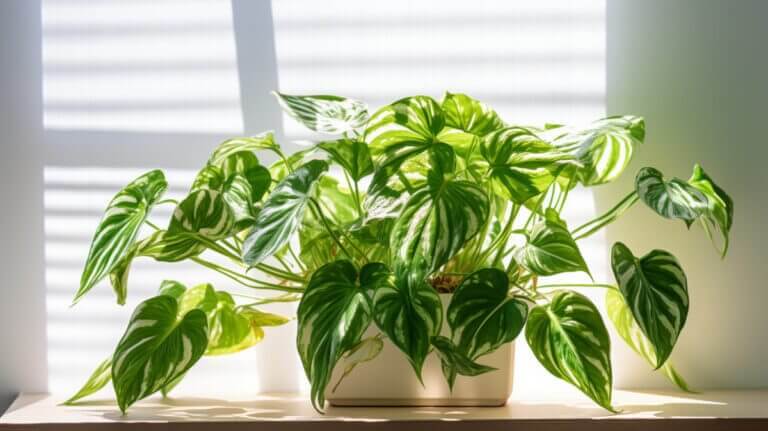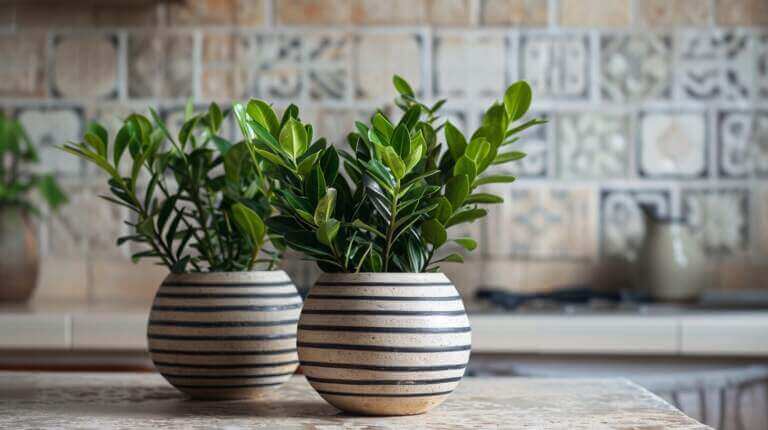Welcome to this informative article on understanding the safety of crown of thorns, a popular houseplant and succulent. Crown of thorns, scientifically known as Euphorbia milii, is native to Madagascar and is known for its sharp thorns and vibrant flowers. However, it is essential to be aware that Euphorbia species, including crown of thorns, can be toxic to both humans and pets. In this article, we will delve into the potential dangers and precautions associated with this beautiful yet poisonous plant.
Key Takeaways:
- Crown of thorns, also known as Euphorbia milii, is a succulent houseplant popular for its thorny stems and colorful flowers.
- The milky white sap of crown of thorns contains phorbol esters, which can cause irritation and gastrointestinal upset if ingested.
- Skin contact with the sap can lead to dermatitis, and prolonged exposure can cause vision loss and blindness.
- When handling crown of thorns, it is important to wear gloves and avoid touching your face, particularly your eyes.
- Pets, including dogs and cats, can also be at risk of crown of thorns toxicity, so it is crucial to keep the plant out of their reach.
Now that we have a brief overview, let’s dive deeper into the symptoms, precautions, and pet safety associated with crown of thorns.
Crown of Thorns Toxicity: Symptoms and Dangers
The crown of thorns plant, also known as Euphorbia milii, poses a significant risk of poisoning if ingested by humans or pets. The entire plant, including the sap, can cause toxicity and a range of symptoms. Some common symptoms of crown of thorns poisoning include irritation or blistering in the throat and mouth, severe stomach or abdominal pain, vomiting, and diarrhea. It is important to note that skin contact with the sap can also lead to dermatitis and swelling.
The sap of the crown of thorns plant contains phorbol esters, which are responsible for its toxic effects. These compounds can cause irritation and gastrointestinal upset if ingested. Prolonged exposure to the sap can also result in skin and eye irritation. In severe cases, vision loss and blindness may occur. Therefore, it is crucial to exercise caution when handling this plant to prevent any adverse effects.
To protect yourself and others from crown of thorns toxicity, it is recommended to wear gloves when handling the plant. Gloves can prevent skin contact with the sap and minimize the risk of skin irritation and dermatitis. Additionally, avoid touching your face, particularly your eyes, while working with the plant. In case of eye contact, rinse immediately with water and seek medical assistance if the irritation persists.
| Symptoms of Crown of Thorns Poisoning | Dangers and Effects |
|---|---|
|
|
|
|
It is important to be aware of the symptoms and dangers associated with crown of thorns toxicity. Taking the necessary precautions when handling the plant and seeking immediate medical attention in case of ingestion or severe symptoms can help ensure the safety and well-being of everyone involved.
Protecting Yourself and Your Pets: Handling Crown of Thorns Safely
When it comes to handling crown of thorns, taking precautions is essential to ensure your safety and the well-being of your pets. The milky white sap of the plant can cause skin irritation and dermatitis, making it important to avoid direct contact. To protect yourself, it is recommended to wear gloves when handling crown of thorns. This will help prevent skin irritation and minimize the risk of any adverse effects.
In addition to wearing gloves, it is crucial to avoid touching your body, particularly your eyes, while working with the plant. If the sap comes into contact with your eyes, rinse them immediately with water and seek medical help if the irritation persists. By being cautious and following these simple measures, you can handle crown of thorns safely and minimize the risk of any discomfort or harm.
It is also important to note that if you have pets in your home, you should take extra care to keep crown of thorns out of their reach. While ingestion of the plant is rare due to its bitter taste and thorns, pets can still come into contact with the sap or other parts of the plant. By keeping the plant away from your pets’ curiosity, you can prevent any potential issues and ensure their safety.
Overall, by following proper handling procedures, such as wearing gloves and avoiding direct contact with the sap, you can safely enjoy the beauty of crown of thorns without any adverse effects. Additionally, taking the necessary precautions to keep the plant out of your pets’ reach will help ensure their well-being. By being mindful and proactive, you can create a safe environment for both yourself and your beloved furry friends.
Tips for Handling Crown of Thorns Safely:
- Always wear gloves when working with crown of thorns to prevent skin irritation and dermatitis.
- Avoid touching your body, especially your eyes, while handling the plant to prevent any potential eye irritation.
- If the sap comes into contact with your eyes, immediately rinse them with water and seek medical help if the irritation persists.
- Keep crown of thorns out of reach of your pets to prevent any accidental ingestion or contact with the plant.
Crown of Thorns and Pet Safety: Keeping Your Pets Away
As a pet owner, I understand the importance of keeping my furry friends safe from potential hazards. When it comes to crown of thorns plants, it’s essential to take precautions to ensure that our pets stay away from this toxic plant. While ingestion of the plant is rare due to its bitter taste and thorns, it is still possible for pets to come into contact with the sap or other parts of the plant. That’s why it’s crucial for us pet owners to be proactive in creating a pet-friendly environment.
If you suspect that your pet has ingested crown of thorns or is experiencing any symptoms of poisoning, it is important to contact your veterinarian immediately. They will be able to provide the necessary guidance and treatment to ensure your pet’s well-being. It’s always better to be safe than sorry when it comes to the health of our beloved pets.
In addition to keeping crown of thorns plants out of reach, it’s also important to ensure that your pet’s environment is free from toxic plants. Educating yourself on the potential hazards of various plant species and regularly checking your pet’s surroundings can go a long way in preventing accidental ingestion or contact. Consider safe alternatives if you have pets or young children in your home, as there are plenty of non-toxic houseplants that can add beauty to your space without posing a risk to your furry friends.
| Pet Safety Tips |
|---|
| Keep crown of thorns plants out of reach |
| Regularly inspect your pet’s environment for toxic plants |
| Know the symptoms of poisoning and contact your veterinarian immediately if you suspect ingestion |
| Consider safe alternatives for houseplants |
By taking these simple steps, we can keep our pets safe and enjoy the beauty of crown of thorns without worry. As responsible pet owners, it’s our duty to create a safe and nurturing environment for our furry friends.
Crown of Thorns as a Houseplant: Benefits and Cautions
When it comes to indoor plants, crown of thorns (Euphorbia milii) is a popular choice. Its vibrant flowers and succulent leaves make it a visually appealing addition to any home. However, it’s important to be aware of the potential dangers it poses, particularly for cats and dogs. Crown of thorns is toxic to pets and can cause harm if ingested.
As a responsible pet owner, it’s crucial to prioritize the safety of your furry friends. If you have cats or dogs in your home, consider alternative houseplants that are non-toxic to pets. Some safe alternatives include spider plants, Boston ferns, and African violets. These plants can still add beauty and greenery to your home while ensuring the well-being of your beloved pets.
Proper care and handling of crown of thorns are also important. When working with the plant, wear gloves to protect your skin from the potentially irritating sap. Avoid touching your face, especially your eyes, to prevent any discomfort or harm. By following these precautions and choosing pet-friendly alternatives, you can create a safe and enjoyable environment for both your plants and your pets.
| Plant Name | Toxic to Cats | Toxic to Dogs |
|---|---|---|
| Crown of Thorns | Yes | Yes |
| Spider Plant | No | No |
| Boston Fern | No | No |
| African Violet | No | No |
Key Takeaways:
- Crown of thorns is a popular indoor plant known for its vibrant flowers and succulent leaves.
- However, it is toxic to cats and dogs and can cause harm if ingested.
- Consider pet-friendly alternatives such as spider plants, Boston ferns, and African violets.
- When handling crown of thorns, wear gloves and avoid touching your face to prevent any potential irritation.
The History and Background of Crown of Thorns
The association of the crown of thorns plant with Christ comes from the legend that Jesus wore a woven crown of thorns made from its stems during his crucifixion. This legend has given the plant its name and added to its significance in religious contexts. The botanical name of the plant, Euphorbia milii, commemorates Baron Milius, who introduced it in France in the 19th century. Since then, crown of thorns has become popular as a garden flower in Southern states like Florida, where it has adapted well to warm climates. It is also commonly grown as an indoor plant due to its ease of growth and colorful flowers.
The history and background of crown of thorns highlight both its religious symbolism and its horticultural significance. The plant’s adaptation to warm temperatures makes it an ideal choice for indoor gardening. Its vibrant flowers and unique appearance add beauty to any garden or home. However, it is important to consider the potential toxicity of crown of thorns, especially when it comes to pet safety. By understanding the history and background of this plant, we can appreciate its cultural and botanical importance while also taking necessary precautions to ensure the well-being of ourselves and our loved ones.
The Legend of the Crown of Thorns
“Legend has it that Jesus wore a crown of thorns made from the stems of the Euphorbia milii plant during his crucifixion.”
| Adaptation | Garden Flower | Name Origin | Association with Christ |
|---|---|---|---|
| Euphorbia milii is well-adapted to warm climates and is commonly grown as an indoor plant. | Crown of thorns is a popular garden flower, especially in Southern states. | The botanical name, Euphorbia milii, commemorates Baron Milius, who introduced the plant in France in the 19th century. | The legend of Jesus wearing a crown of thorns made from this plant’s stems adds to its association with Christ. |
Crown of Thorns: Toxicity in Different Species
It is important to be aware that crown of thorns (Euphorbia milii) is toxic to various species, including dogs, cats, humans, horses, and sheep. Ingestion of any part of the plant can lead to toxicity, resulting in symptoms such as gastrointestinal upset, skin irritation, and abdominal pain. Pet owners and individuals should take the necessary precautions to ensure the safety of themselves and their animals.
When it comes to dogs and cats, crown of thorns can be particularly dangerous if ingested. The plant’s toxic compounds can cause gastrointestinal distress, including vomiting and diarrhea, in our furry friends. It is crucial to keep crown of thorns plants out of their reach to prevent any accidental ingestion.
While humans can also experience toxicity symptoms from crown of thorns, it is important to note that cases of severe toxicity are rare. However, skin contact with the plant’s sap can lead to dermatitis and skin irritation. It is advisable to use gloves when handling the plant and to avoid touching your face or eyes after contact to minimize the risk of irritation.
| Species | Toxicity |
|---|---|
| Dogs | Toxic |
| Cats | Toxic |
| Humans | Poisonous |
| Horses | Poisonous |
| Sheep | Poisonous |
By understanding the potential toxicity of crown of thorns to different species and taking appropriate precautions, such as keeping the plant out of reach of pets and wearing gloves when handling it, you can ensure the safety of yourself, your pets, and any other animals in your care.
Conclusion: Understanding and Managing Crown of Thorns Safety
To summarize, it is essential to prioritize crown of thorns safety, particularly when it comes to the well-being of pets. Being aware of the potential dangers and symptoms of crown of thorns poisoning is the first step in ensuring the safety of yourself, your furry friends, and your loved ones.
By taking necessary precautions, such as wearing gloves to avoid skin contact with the sap and keeping the plant out of reach of pets, you can minimize the risk of any adverse effects. It is also important to promptly seek veterinary assistance if you suspect any ingestion or if your pet shows any signs of poisoning.
Additionally, educating yourself on toxic plants and considering safe alternatives is crucial, especially if you have pets or young children in your home. This proactive approach will help create a safe environment where you can enjoy the beauty of crown of thorns without compromising anyone’s health.
In conclusion, understanding and managing crown of thorns safety is a responsible and necessary step for plant owners and pet owners alike. By being informed, taking precautions, and prioritizing the safety of your loved ones, you can confidently enjoy the beauty of crown of thorns while keeping everyone protected from the potential hazards of toxic plants.
FAQ
Are Euphorbias toxic to pets?
Yes, Euphorbias, including crown of thorns, are toxic to pets. Ingestion or contact with the sap can cause toxicity and various symptoms.
What are the symptoms of crown of thorns poisoning?
Symptoms of crown of thorns poisoning include throat and mouth irritation, severe stomach pain, vomiting, diarrhea, skin irritation, and dermatitis.
How can I handle crown of thorns safely?
To handle crown of thorns safely, it is recommended to wear gloves to avoid skin contact with the sap. Avoid touching your body, especially your eyes, while working with the plant.
Is crown of thorns toxic to pets?
Yes, crown of thorns is toxic to pets, and it is important to keep it out of their reach. Ingestion or contact with the plant can cause harm to pets.
What should I do if my pet ingests crown of thorns?
If you suspect that your pet has ingested crown of thorns or is showing symptoms of poisoning, contact your veterinarian immediately for guidance.
Can I have crown of thorns as a houseplant?
While crown of thorns can be a houseplant, it is important to be cautious if you have pets or young children. Consider safe alternatives to ensure their safety.
What is the historical significance of crown of thorns?
Crown of thorns is named after the legend that Jesus wore a woven crown made from its stems during his crucifixion. It has a religious and horticultural significance.
Is crown of thorns toxic to different species?
Yes, crown of thorns is toxic to various species, including dogs, cats, humans, horses, and sheep. All parts of the plant can cause toxicity if ingested.
How can I understand and manage crown of thorns safety?
By being aware of the potential dangers, taking necessary precautions, and educating yourself on toxic plants, you can ensure the safety of yourself, your pets, and your loved ones.







